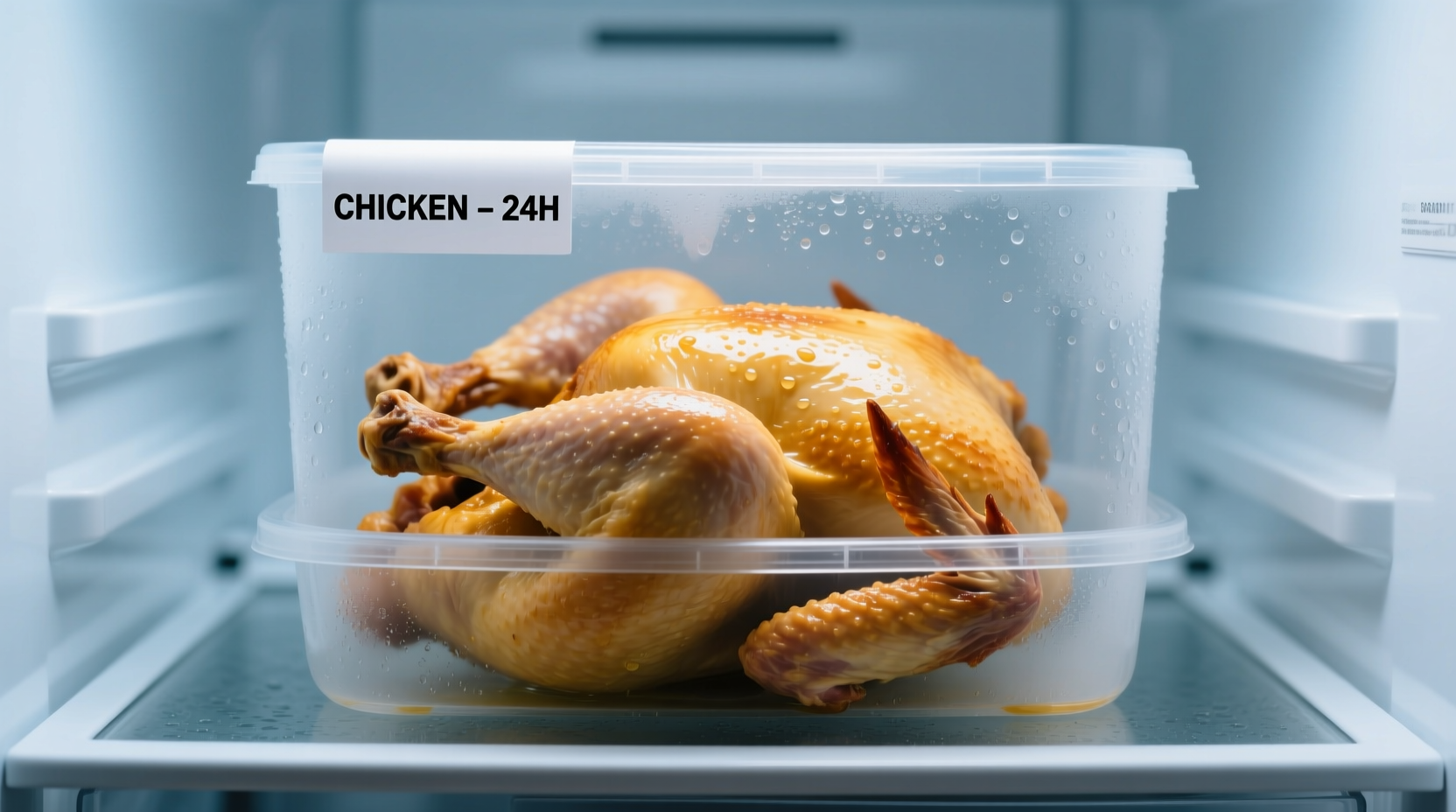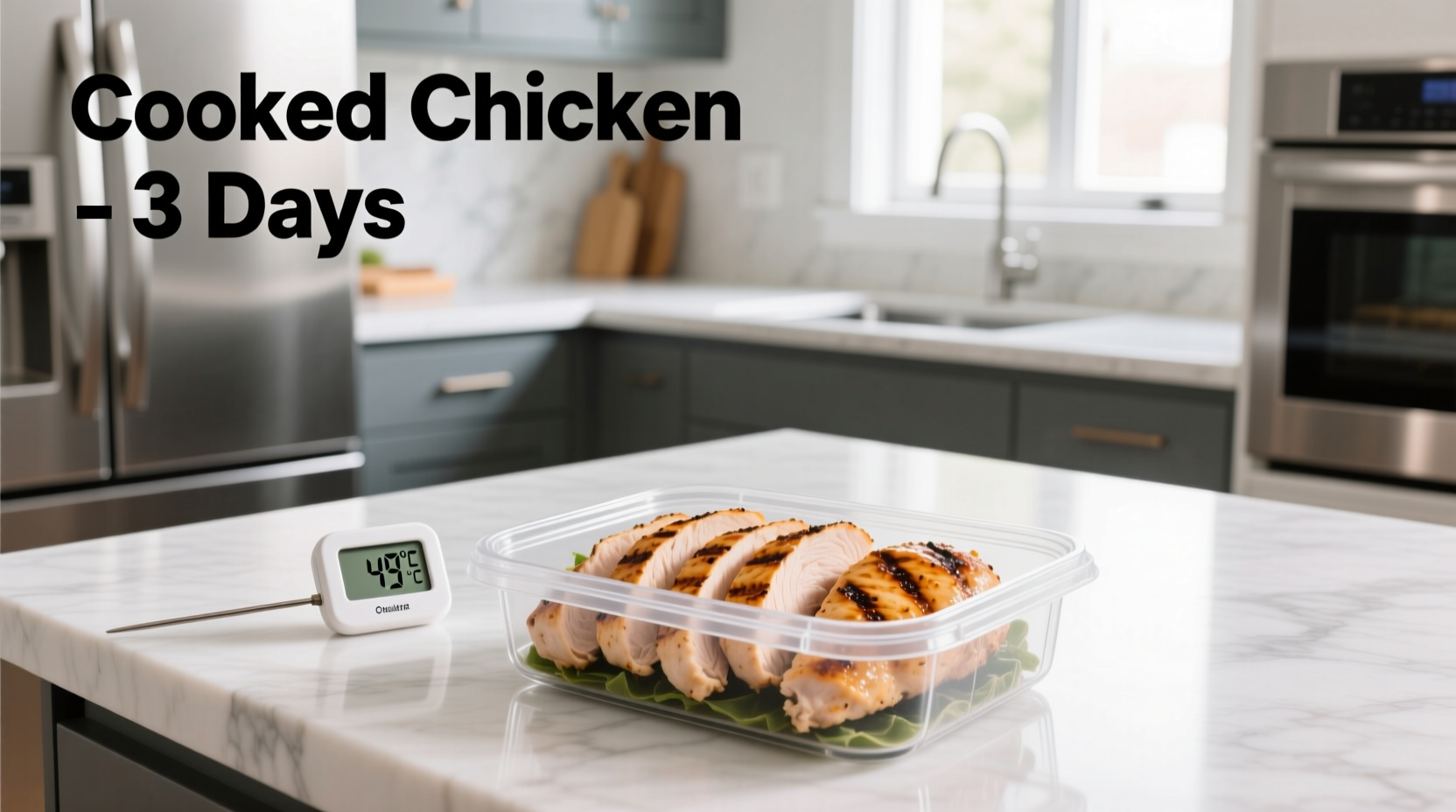Cooked chicken stays safe to eat for 3-4 days when stored properly in the refrigerator at 40°F (4°C) or below. This timeframe comes directly from the USDA Food Safety and Inspection Service, the authoritative source for food safety guidelines in the United States.
Wondering if that leftover chicken from Sunday's roast is still safe for tonight's dinner? You're not alone. Millions of home cooks face this question weekly, and getting it wrong could lead to foodborne illness. Let's cut through the confusion with science-backed guidelines you can trust.
Why Proper Chicken Storage Matters for Your Health
Cooked chicken provides an ideal environment for bacteria growth when left at unsafe temperatures. Pathogens like Salmonella and Campylobacter multiply rapidly between 40°F and 140°F—the "danger zone" for food safety. According to the CDC, these bacteria cause approximately 1.35 million illnesses annually in the United States.
Official Food Safety Guidelines You Can Trust
The USDA Food Safety and Inspection Service (FSIS) maintains the gold standard for food storage recommendations. Their research shows that properly stored cooked chicken remains safe for consumption for:
- 3-4 days in the refrigerator (at 40°F or below)
- 2-6 months in the freezer (at 0°F or below)
These timeframes aren't arbitrary—they're based on bacterial growth studies conducted under controlled laboratory conditions. The USDA specifically states: "Use cooked poultry within 3 to 4 days. For longer storage, freeze it."
Factors That Shorten Your Chicken's Safe Storage Time
Not all cooked chicken lasts the full 4 days. Several factors can accelerate spoilage:
- Initial cooking temperature - Chicken not cooked to 165°F may contain more surviving bacteria
- Cooling time - Chicken left at room temperature for more than 2 hours before refrigeration
- Storage container - Open containers expose chicken to more air and contaminants
- Refrigerator temperature - Units running above 40°F accelerate bacterial growth
- Handling practices - Using contaminated utensils when serving leftovers
How to Spot Spoiled Cooked Chicken: The Visual Guide
While dates provide a guideline, your senses offer the most reliable spoilage detection. Refer to this evidence-based spoilage indicator table:
| Condition | Fresh Cooked Chicken | Spoiled Cooked Chicken |
|---|---|---|
| Appearance | Bright, consistent color | Grayish hue, slimy film, mold spots |
| Smell | Mild, pleasant aroma | Sour, ammonia-like, or sulfur odor |
| Texture | Firm, slightly moist | Slippery, sticky, or excessively dry |
| Taste (if questionable) | Normal flavor | Sour or "off" taste (do not taste if other signs present) |
When in doubt, throw it out. Consuming spoiled chicken carries significant health risks that outweigh the cost of replacement.

Maximizing Your Leftover Chicken's Shelf Life: Proven Storage Methods
Follow these evidence-based storage techniques to ensure your cooked chicken reaches the maximum safe storage window:
- Cool rapidly - Divide large portions into shallow containers to cool within 2 hours of cooking
- Seal properly - Use airtight containers or wrap tightly with heavy-duty aluminum foil or plastic wrap
- Store strategically - Place in the coldest part of your refrigerator (usually the back, bottom shelf)
- Keep consistent temperature - Verify your refrigerator maintains 40°F or below with an independent thermometer
- Label containers - Note the storage date to track freshness accurately
Reheating Leftover Chicken Safely
Proper reheating is as crucial as storage for food safety. The USDA recommends:
- Reheat to an internal temperature of 165°F (use a food thermometer for accuracy)
- Stir food reheated in a microwave to eliminate cold spots
- Consume reheated chicken immediately—don't store leftovers again
- Avoid repeated reheating cycles which degrade quality and safety
Freezing Cooked Chicken for Long-Term Storage
When you can't finish chicken within 4 days, freezing preserves safety and quality:
- Portion chicken before freezing for convenient thawing
- Use freezer-safe containers or vacuum sealing to prevent freezer burn
- Remove as much air as possible from packaging
- Label with contents and date (use within 4 months for best quality)
- Thaw in the refrigerator, not at room temperature
Common Misconceptions About Cooked Chicken Storage
Let's address some persistent myths that could put your health at risk:
- "If it smells okay, it's safe" - Many dangerous bacteria don't produce noticeable odors
- "The 5-second rule applies to leftovers" - Bacteria transfer begins immediately upon contact
- "I can just cut off the moldy part" - Mold roots penetrate deeper than visible, and toxins may have spread
- "My refrigerator is cold enough because it feels cold" - Use a thermometer—most home units run warmer than settings indicate
When Leftovers Become a Health Risk
Consuming chicken stored beyond recommended timeframes carries real health consequences. The USDA reports that improperly stored cooked poultry is among the top 10 causes of foodborne illness outbreaks. Symptoms of food poisoning typically appear 6-48 hours after consumption and may include:
- Nausea and vomiting
- Diarrhea (sometimes bloody)
- Abdominal cramps
- Fever and chills
- Headache and body aches
Vulnerable populations—including young children, elderly adults, pregnant women, and immunocompromised individuals—face higher risks of severe complications from foodborne pathogens.
Practical Leftover Management Strategy
Create a simple system to prevent food waste while maintaining safety:
- Store leftovers in clear containers for visual inventory
- Implement a "first in, first out" system in your refrigerator
- Designate one shelf specifically for leftovers
- Plan one "leftover night" weekly to clear aging items
- When storing multiple items, place newer containers behind older ones











 浙公网安备
33010002000092号
浙公网安备
33010002000092号 浙B2-20120091-4
浙B2-20120091-4